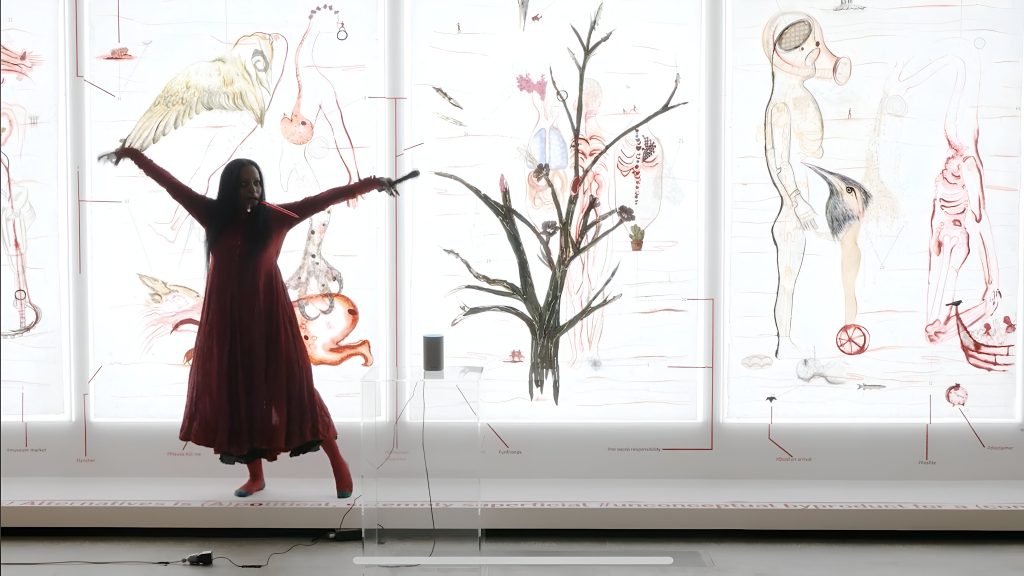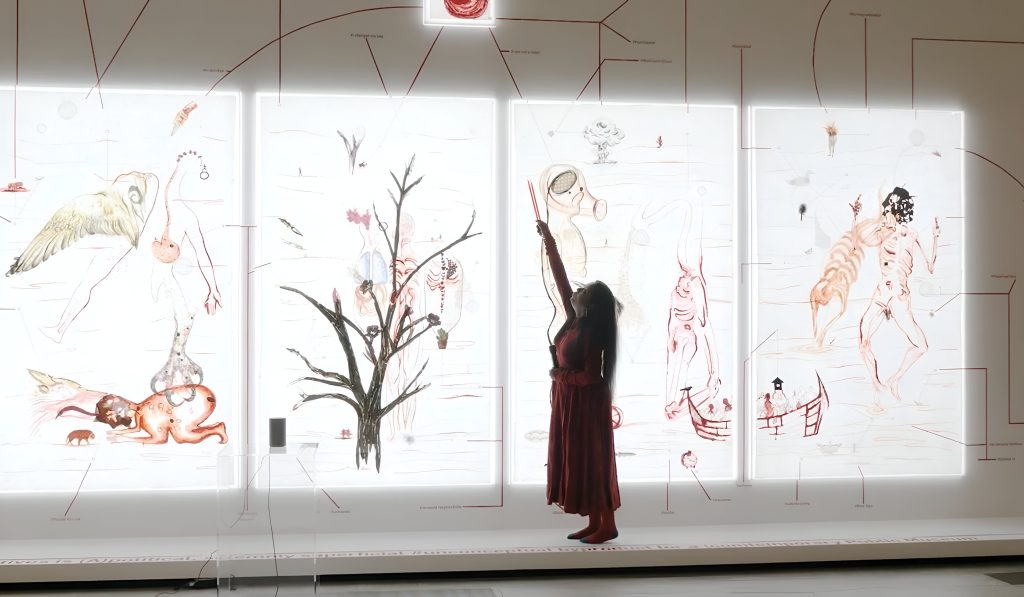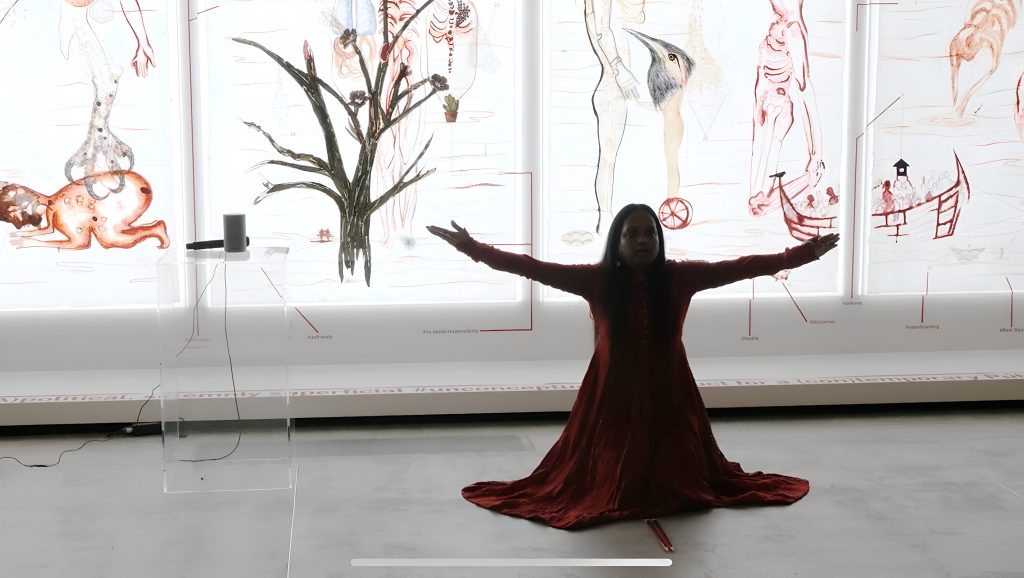Anatomy of Disconnection
AUTHOR
Sneha Biswas
To perceive and experience knowledge, one must have a body. The body is essential for orienting us in the world, and our sense of self and perception is deeply rooted in our bodily experience. The body is not just a depersonalised physical entity, nor is it merely a ‘tool’ for perception; rather, it serves as the ‘zero point’ of perception from which we perceive everything else. This notion of consciousness as ‘an experiential category’ was central to the works of phenomenologists like Husserl and Heidegger, and it was Maurice Merleau-Ponty who, expanded on his predecessors’ works and placed the body at the heart of human consciousness. In Phenomenology of Perception (1945), Merleau-Ponty critiqued the timeless mind-body dichotomy of Cartesian logic and argued that consciousness is inextricably linked to our bodily acts of perception and that the body therefore is experienced from within as the medium through which we perceive and engage with the world.[1] This body of ‘lived experience’ is not devoid of intentionality as it corporealises and historicises our sense of self through its immediate symbolic interactions that are deeply intertwined with socioeconomic and gender identities, political interests, power dynamics, and oppression. [2] Acts of human creativity are similarly embodied, and one must not overlook how the intricacies of language function in the body’s realisation of such creative knowledge. I will engage with this idea of ‘creative embodiment’ in the performative speech exchange of Mithu Sen with the voice assistant Alexa, in Sen’s performance UnMYthU: UnKIND(s) Alternatives Performance, held on November 24, 2018, at the Gallery of Modern Art, Brisbane.

The performance begins with Mithu Sen playfully scampering toward a live Alexa device placed at the centre of the gallery space. The surface of the backdrop wall is adorned with large-scale idiosyncratic illustrations of unconventional anatomical figures. Sen greets Alexa in a cheerful tone (“Alexa, how are you?”) to which Alexa responds cordially: “Glad you asked…let’s get talking.” However, Mithu’s subsequent unintelligible gibberish leaves Alexa and the audience baffled. For the next 25 minutes, through probing questions couched in verbal and gesticular demonstrations of incoherence, Sen delves into issues of forced migration, human displacement, and politically motivated torture. Despite Sen’s insistence, Alexa often fails to comprehend the questions, responding with unrelated information or disinterested objectivity. “Alexa, do you know my language? … Do you love me? … Alexa, I love you! … Alexa, I want to kill you!” These are some of the powerful, sentimental clusters of words, delivered in their full materiality, as part of the performance. However, they do not seem to produce any affective response in their addressee as the artificial intelligence of Alexa appears incapable of grasping the nuances and passion of Sen’s humane utterances. When Alexa fails to identify Alan Kurdi, the two-year-old Syrian refugee who drowned while seeking asylum, Sen responds with raucous laughter and disdainful astonishment. Similarly, when Alexa describes the torture method of waterboarding, Sen resumes her gibberish oration in a rallying gesture directed at the audience. At one point, Alexa mistakes ‘dead’ for ‘date’ in formulating her response to a question, immediately prompting Mithu’s sarcastic remark, “Alexa, you’re so brilliant!”

The most crucial moment of the performance occurs when Sen inquires about Alexa’s gender and whether Alexa is capable of love and making love. Alexa responds “female in character” to the first question and admits ignorance to the second. Sen subsequently challenges Alexa’s answer to the first question by performing a gesture of pointing at the atypical anatomical drawings in the background. Even though we do not understand Sen’s speech, her theatrical bodily gestures clearly convey that Alexa lacks an organic physical body and, therefore, does not exhibit any anatomical markers of a gendered female identity. Without a corporeal body of flesh and blood, Alexa does not have the cognitive ability to have an embodied experience of its ‘femaleness’ that human individuals possess. Similarly, the act of making love is an emotional gesture rendered through physicality. Alexa lacks both the mind and body in the phenomenological notion to understand these concepts. Mithu does not miss the opportunity to raise this pertinent concern to her discourse partner in this interlocutory performance: “Alexa, do you have a mind?” The performance concludes with Mithu Sen resting on her knees, simulating rowing and swimming motions, gradually slowing down these hand movements until she finally quiets down, ending the performance in a child’s pose symbolising an end, or death. Perhaps it is a homage to Alan Kurdi’s unrealised quest for a sense of safe inhabitation.
The speech exchange between Mithu Sen and Alexa offers us a contrasting demonstration of “habitual speech” and “protagonistic speaking”[3]. While habitual speech concerns syntactical accuracy and general appropriateness, protagonistic speaking embodies personalised, emotive expression with an “embodied and enactive interest”[4]. When Mithu Sen engages passionately with Alexa in performative dialogue, Alexa responds in a manner reflective of a generalised habitual body, drawing on pre-reflexive knowledge repositories, but its speech lacks the personal and reflexive aspects of the ‘actual body’. Alexa fails to truly engage in dialogue with Mithu Sen, instead offering standardised grammatical fluency and encyclopaedic information in response to Sen’s emotionally charged, persuasive utterances. Alexa exhibits no sense of inhabitation within the speech it produces—no symbolic connection, no embodied sensibility. In contrast, Mithu Sen’s animated parole epitomises human speech as a performative bodily act deeply rooted in individual experience and perception of reality.
In his 1972 book What Computers Can’t Do, Hubert Dreyfus argued against the notion of AI supremacy over human intelligence by highlighting AI’s inability to exhibit the human body’s phenomenological ability of immediate coping or optimal ‘grasping’ of a situation. Dreyfus contended that machines lack this “inter-corporeality” — the embodied engagement with the environment that is fundamental to human experience. [5] Following Dreyfus’ argument, it may even be inaccurate to assign Alexa the minimum status of a habitual body as true habituality requires a body capable of correlating with its environment, something Alexa fails to demonstrate in its ‘dialogue’ with Mithu Sen. Rather Alexa is transformed into a creative tool during the performance, serving as a prosthetic extension of the intending artist’s body. Mithu Sen brilliantly subsumes Alexa’s existence into her performance, using it to ‘dilate’ her (bodily) presence within her immediate world of the performance act.
Dreyfus thoroughly critiqued the model of symbolic representation[6] and inference rules that still continue to underpin today’s AI and machine learning systems like Alexa. He argued for the primacy of the human phenomenological body over AI’s symbolic representation model, emphasising the knowledge experiences of the human body, which dynamically engages with the world using its full emotional faculties. Without such embodied knowledge in the phenomenological sense, Alexa cannot position itself as a ‘site’ capable of understanding the human world, making it incomprehensible despite using pre-recorded internal models. This inability prevents Alexa from authentically reproducing meaningful interactions with the human subject.
While Alexa may exhibit normative intelligence, it pales in comparison to the human intellectuality displayed in Mithu Sen’s performative body language, in flesh and blood. The magnificent inventions of the artist’s lived experience fleshed out in their creativity, will always eclipse the cold efficiency of technology.

Declaration: The images have been produced as screenshots from QAGOMA’s official YouTube channel, taken from the documented performance of Mithu Sen with an Alexa device, commissioned for ‘The 9th Asia Pacific Triennial of Contemporary Art’ © Mithu Sen. To the best of my knowledge, the images have been used following fair use copyright policy and do not knowingly breach any copyright issues.
References
Dreyfus, Hubert L. The Current Relevance of Merleau-Ponty’s Phenomenology of Embodiment. Electronic Journal of Analytic Philosophy, 1998.
Dreyfus, Hubert L. What Computers Can’t Do: A Critique of Artificial Reason. Harper & Row, 1972.
Foucault, M. The History of Sexuality, Volume 1: An Introduction. Pantheon Books, 1978.
Kreisler, Harry. Conversations with History: Hubert Dreyfus. Interview with Hubert Dreyfus. University of California Television (UCTV), September 2006. Show ID: 11335.
Merleau-Ponty, M. The Phenomenology of Perception. Translated by Donald A. Landes, Routledge, 2013.
Moya, Patricia. Habit and Embodiment in Merleau-Ponty. Frontiers in Human Neuroscience, July 2014.
Notes
[1] Throughout the pages of Phenomenology of Perception (1945), particularly in the chapter “The Cogito”, Merleau-Ponty critiques the Cartesian cogito and formulates a notion of the mind as a self-consciousness that interacts with a cultural world through ‘lived-through’ correspondences.
[2] The body as ‘lived experience’ points to Merleau-Ponty’s concept of the ‘embodied subject’ discussed in his Phenomenology of Perception (1945) which can can be further understood by drawing upon Foucault’s ideas of the inherent power relations within diverse realms of social existence, such as language, sexuality, and disciplinary mechanisms—a recurring theme throughout all his writings, particularly in Discipline and Punish (1975) and The History of Sexuality (1976).
[3] I have improvised the terms “habitual speech” and “protagonistic speaking” from Merleau-Ponty’s distinction between the “habitual body” and the “actual body” where the former represents a “generalized existence” tied to the effectiveness of action whereas the “actual body” is a protagonistic, first-person perspective of the lived body as it understands a situation by “inhabiting” knowledge of it.
Merleau-Ponty, Maurice. 2002. Phenomenology of Perception. N.p.: Taylor & Francis.
[4] Ibid.
[5] During his interview with Harry Kreisler in 2006, Hubert Dreyfus counters the popular notion during his time that the “mental representation” model of AI is equivalent to the nature of human cognition. He emphasises the primacy of human bodies as embodied beings, referring to Merleau-Ponty’s emphasis on the centrality of the body geared into a direct, dynamic interaction with the world.
[6] The model of symbolic representation became the foundational model of human intelligent consciousness upon which machine intelligence of computers was built. It aimed to replicate the Cartesian model of mental representation of human consciousness characterised by a pre-reflexive knowledge of the world. This model became broadly validated in the popular as well as scientific discourses on AI supremacy in the later half of the twentieth century. Throughout his scholarly career, Dreyfus argued otherwise, stating that the phenomenological body is the true human consciousness.
About the Author
Sneha Biswas is an art practitioner and researcher, thoroughly engaged in the intersections of visual arts, critical thinking, and psychoanalysis. She has a BA in English Literature from Calcutta University (2015-2018) and an MFA in Art History from Kala Bhavana, Visva Bharati University (2020-2023). She is currently pursuing her second MA in English Literature from Jadavpur University (2023-ongoing). She hopes to blissfully spend the later years of her life making art, writing, and perhaps, running a magazine!

